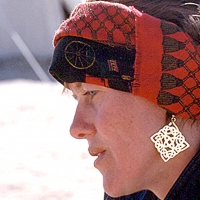Mummies with Ink
Recent Discoveries of Tattoos in Ancient Egypt
Anne Austin
Tattoos have long been used to express individuality and to show others how the wearer wants to be identified. Texts are virtually silent on the practice in Ancient Egypt, and art historical evidence is unclear. However, in 2014 an extensively tattooed mummy was identified from the community of workers who cut and decorated the New Kingdom’s royal tombs at Deir el-Medina. Since then, many other individuals with tattoos have been identified among the numerous unpublished human remains at the site. This talk discusses these tattooed individuals, including the most recent finds from 2019.
|
Women and Trade in Ancient Egypt
Juan Carlos Moreno Garcia
By exploring Ancient Egyptian papyri, inscriptions, and figurines it is possible to envision a world of economic exchanges in which women displayed considerable independence. This talk discusses depictions of women as active participants in trade and exchange, sometimes traveling long distances even with nursing infants.
|
The Power of Images in Ancient Egyptian
Rune Nyord
Ancient Egyptian material culture is full of images, much like today’s online media. Similarly, the Egyptians had “portraits” made that were idealized beyond recognition or even borrowed other peoples’ features. This talk discusses a number of examples that demonstrate how the Egyptians thought of an image (and its possible enhancements), as well as the use of figurines and drawings used to “magically” effect the depicted persons.
|
How the Female Body Works
Ancient Egyptian Concepts of Female Anatomy, Physiology, Medicine and Magic
Tanja Pommerening
No Ancient Egyptian texts exist that describe the anatomy of women in detail. However, it is possible to partially reconstruct their ideas of the female, in terms of body and reproductive functions. This reconstruction makes full use of texts concerning gynecology and obstetrics, including diagnostic texts, prescriptions, fertility and pregnancy tests, and also includes magical incantations and spells, magical objects and sources from non-medical contexts.
|
On the Verge of Writing
Andréas Stauder
Writing is argued to be invented in late fourth millennium Egypt to meet the information-tracking needs of the burgeoning state. This talk examines writing from another perspective, abandoning the categorical definitions and their underlying assumptions.
|
Meant to Impress: Messages from Egyptian Tombs
How tomb facades communicate with the passerby
Julie Stauder-Porchet
At the elite necropolis of Qubbet el-Hawa, three extensively inscribed tombs address the passerby, not only through the hieroglyphs, which could have been read by only a few, but also through their overall visual impact. Although Qubbet el-Hawa was the place farthest away from the capital Memphis, these inscribed facades project multiple lines of connectivity with the Memphite center, and thus the king.
|
Placentas, Sieves, and the Ancestors
Examining Hieroglyphs in Context
Willeke Wendrich
For years Egyptologists have interpreted hieroglyphs without regard to their context. One such example, designated AA1, was long thought to represent a placenta, and more specifically the placenta of the king of Egypt. However, a different, more complex, meaning is likely when time and place are carefully considered.
|
Ripped from the Headlines – Of Ancient Egypt
Fear-based Violence Against Foreigners Spreads to Native Population
Jonathan Winnerman
The Ancient Egyptians were notoriously xenophobic. Images of the king smiting stereotyped foreigners appear prominently in temples and tombs, and violence against such peoples was an integral part of magical practices. The purpose of this violence is often explained away as the maintenance of an ideal social order and the protection of a peaceful Egypt from the chaos caused by invading foreigners. Yet, such interpretations are complicated by the inclusion of native Egyptians among these tormented peoples. This talk will analyze such inclusions and consider how violence against foreigners is often intrinsically linked to violence against one’s own population.
|
Women & Power in Ancient Egypt
Kathlyn M. Cooney
A woman’s power in the ancient world (and perhaps even today) was always compromised from the outset, and this lecture will address the root causes of this social inequality. Given this social reality in the ancient world, how then did women negotiate their limited leadership roles? Were they able to rule “behind the throne” so to speak? How are we to find a woman’s power when it was so habitually cloaked by a man’s dominance? This lecture will address those questions and ask how much of this ancient reality still touches us today.
|










